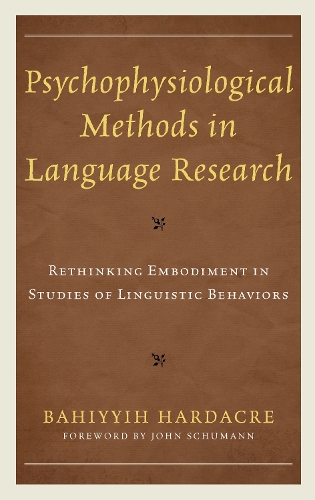
Psychophysiological Methods in Language Research: Rethinking Embodiment in Studies of Linguistic Behaviors
(Hardback)
Publishing Details
Psychophysiological Methods in Language Research: Rethinking Embodiment in Studies of Linguistic Behaviors
By (Author) Bahiyyih Hardacre
Foreword by John Schumann
Bloomsbury Publishing PLC
Lexington Books
12th November 2020
United States
Classifications
Professional and Scholarly
Non Fiction
Education / Educational sciences / Pedagogy
Bilingualism and multilingualism
Physiological psychology, neuropsychology, biopsychology
410.19
Physical Properties
Hardback
220
Width 159mm, Height 230mm, Spine 18mm
481g
Description
Psychophysiological Methods in Language Research: Rethinking Embodiment in Studies of Linguistic Behaviors by Bahiyyih Hardacre is a guide for adopting a transdisciplinary and multidimensional approach to language research. Language research areas that could benefit from psychophysiological methods are first/second/foreign language learning, teaching, use, assessment, performance, anxiety, motivation, attitudes, ideologies, perceptions, and identities, among others. To aid researchers in deciding on a suitable physiological measurement method, this book provides an overview of each of the most popular physiological measurements today, along with their potential applications in language research. Bahiyyih Hardacre explains what each of the physiological methods can tell us, illustrates how each physiological method can inform language research by citing a few language studies that used that particular measurement, and provides information about the appropriate procedures for data collection and data processing.
Reviews
"This wonderful book is loaded with practical and innovative methods you can use to study language from a psychophysiological perspective."
-- Emre Guvendir, Trakya University"This book is an important step and contribution to applied linguistics. Hardacre puts forth some of the current research methods available to analyzing multi-modal discourse beyond the visual and external. It is imaginative and exciting. It demonstrates the hard transdisciplinary training that will be required of any researcher who would endeavor to explore the physiological and neurobiology bases of social interaction at the level of turn-taking, pauses, gaze, gesture, and body orientation. Fortunately, Hardacre has undertaken the hard work and has shown the possibilities, which should excite applied linguists and psychophysiologists."
-- Anna Dina L. Joaquin, California State University NorthridgeAuthor Bio
Bahiyyih Hardacre is assistant professor in the division of Applied and Advanced Studies in Education at California State University, Los Angeles.
